Frame for Work (possible book, v1, 2024)
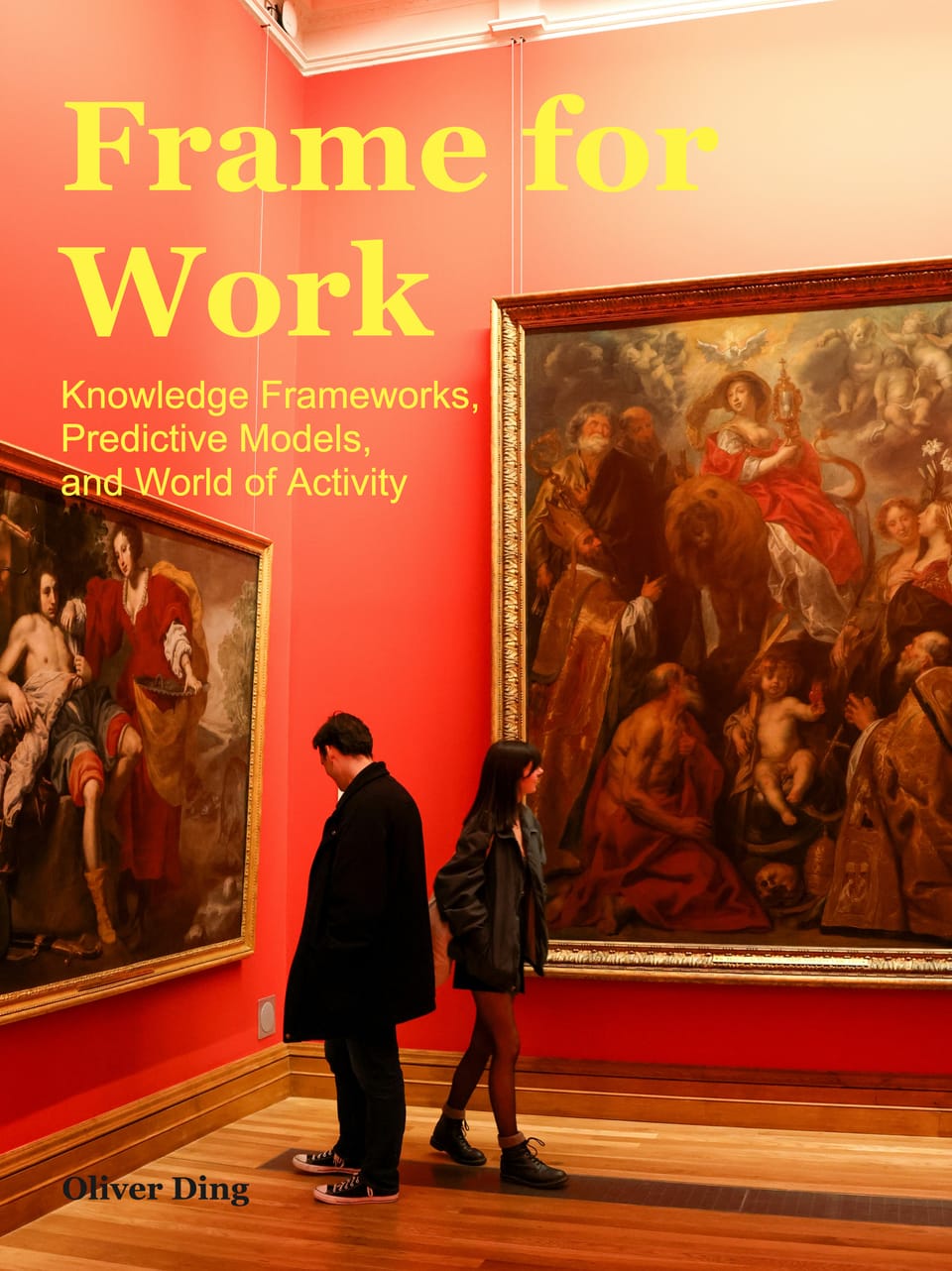
Knowledge Frameworks, Predictive Models, and World of Activity
by Oliver Ding
This article, originally written on December 21, 2024, serves as an introduction to my 2024 book draft, Frame for Work.
The “Frame for Work” theme was born on Jan 30, 2023. Over time, it inspired a series of related projects and eventually became a project in its own right.
A few days ago, I wrote an article titled Creative Frameworks for the Strategic Life Narrative Project. After publishing it, I realized it was time to curate my articles on Knowledge Frameworks and related themes and edit them into a possible book titled Frame for Work.
This Possible Book aims to serve as a collection and reference for the theme. While it can be considered a draft for a formally published book, it also stands as an independent creation, using a systematic framework to organize theoretical ideas, intermediate frameworks, and practical tools such as diagrams, thematic maps, and case studies.
This article serves as an Introduction and a Table of Contents of the possible book, you can see the entire structure of the future book, and see articles under each chapter through links.
Some numbers about the possible book:
- 8 parts
- 35 chapters
- 39 primary articles
- 651 minutes of reading time
- 172,515 words (about 345 single-spaced pages)
The following sections recommend a total of 81 articles, some of which are secondary articles.
Contents
The “Frame for Work” Project
A Predictive Model for a Possible Book
A New Possible Book
Part 1: IntroductionPart 2: A Theory of Knowledge Frameworks
Part 3: Building a Knowledge Framework
Part 4: Predictive Models
Part 5: Maps and Methods
Part 6: World of Activity
Part 7: Adjustable Wisdom
Part 8: The Evolving Creative Enterprise
A New Knowledge Center
The “Frame for Work” Project
The “Frame for Work” theme was born on January 30, 2023. Over time, it inspired a series of related projects and eventually became a project in its own right.

I used the image above — a Thematic Card — to represent the “Frame for Work” theme. At times, I also changed the sub-title, which slightly shifted the meaning of the theme.
- Jan 30, 2023: An Ontology of Knowledge Frameworks
- April 1, 2024: Knowledge Frameworks and the Richness of Variants
- December 18, 2024: Knowledge Frameworks, Predictive Models, and World of Activity
More details can be found in the posts below:
- May 10, 2023: TALE: A Possible Theme called “Frame for Work”
- August 22, 2024: The “Frame for Work” Project (2024)
The development of the “Frame for Work” project is embedded within my other projects, such as the Attachange Theory project, the Concept Development project, the Thematic Space project, and the Life-as-Activity project.
The diagram below illustrates the complex relationship between Knowledge Frameworks, Concepts, Diagrams, Thematic Spaces, and Activity.

The diagram employs the “Variant > Quasi-invariant > Invariant > Invariant Set” schema to explain six units of analysis. There is no strict one-to-one correspondence between each row.
- The “Concept” level is about the transformation between themes and concepts.
- The “Framework” level is about the emergence of knowledge frameworks.
- The “Diagram” level is about the external visual representations of knowledge frameworks.
- The “Thematic Space” level is a middle level that connects “Activity” and “Framework.”
- The “Activity” level is about different patterns of actions.
- The “Affordance” level is related to the Operation level of Activity.
You can find more details in Social Moves: An Integrated Ecological Approach to Social Cognition.
This meta-framework provides a broad landscape for understanding the Knowledge — Wisdom — Activity connection. It serves as a context for many of my knowledge projects and has inspired several related book drafts.
In these books, I often mentioned and discussed Knowledge Frameworks. However, they were not the primary object of these books.
In this article, I will edit a new possible book for the “Frame for Work” theme, giving Knowledge Frameworks an independent stage and using it to close the “Frame for Work” project (Phase I).
A Predictive Model for a Possible Book
The book is curated using a multi-perspective approach, incorporating several theoretical frameworks as resources to support diverse practices. The diagram below highlights four perspectives:
- Frame in Make
- Frame in Use
- Frame in Diagram
- Frame in Form
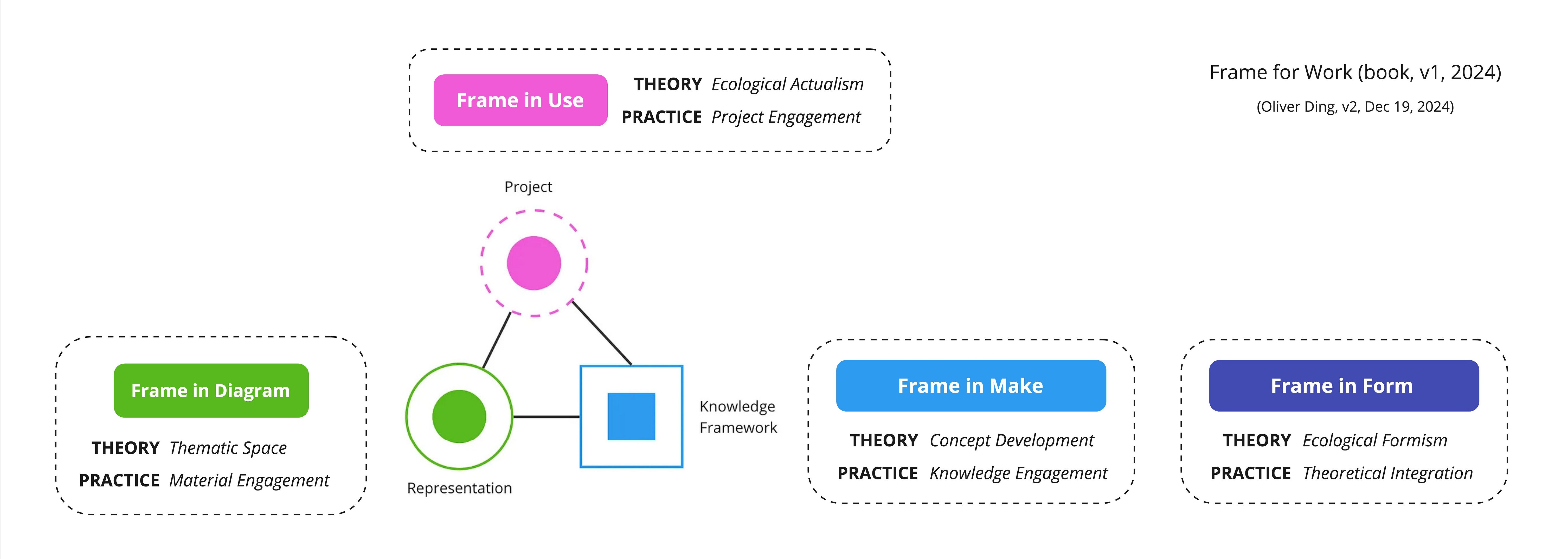
The Frame-in-Make perspective focuses on building brand-new knowledge frameworks. This process involves Knowledge Engagement, particularly in the transformation from “Theme” to “Concept” to “Framework.” A corresponding theoretical resource is the Concept Development framework.
The Frame-in-Use perspective addresses real-life activities that utilize knowledge frameworks as predictive models for Project Engagement. A corresponding theoretical resource is the Ecological Actualism framework.
The Frame-in-Diagram perspective emphasizes creating diagrams as representations of knowledge frameworks and predictive models. This perspective centers on Material Engagement. A corresponding theoretical resource is the Thematic Space Theory framework.
The Frame-in-Form perspective involves curating various knowledge frameworks into a meaningful whole, bridging THEORY and PRACTICE. This perspective focuses on Knowledge Curation and Theoretical Integration. A corresponding theoretical resource is the Ecological Formism framework.
These four perspectives are positioned around the “Knowledge Framework — Project — Representation” schema, which forms the middle layer of the Evolving Knowledge Enterprise. In my creative journey, this model has also expanded to encompass the Creative Enterprise, covering both knowledge and cultural enterprises.
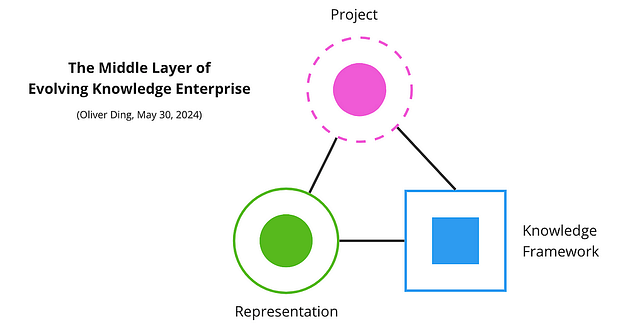
Additionally, the book incorporates four types of actors and their World of Activity in the landscape of engaging with knowledge frameworks.
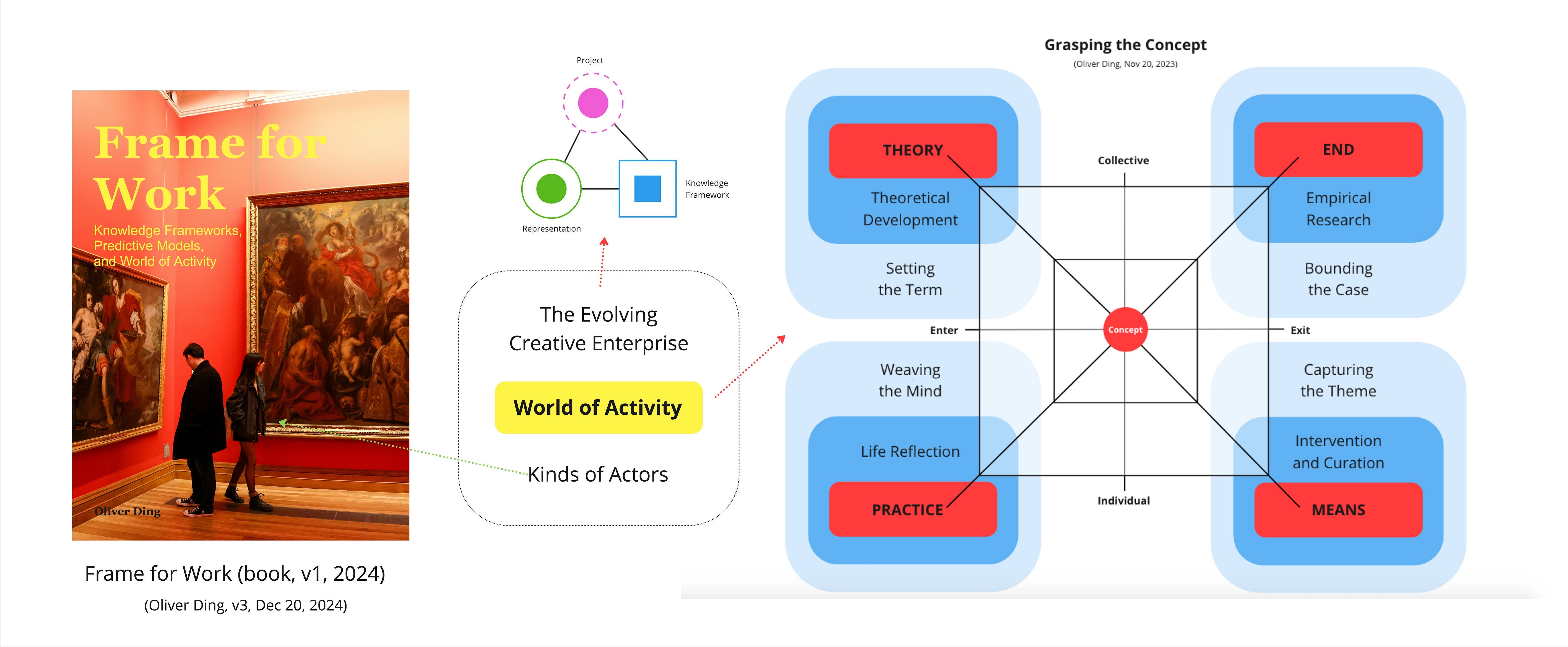
The concept of World of Activity describes a creative person’s maximum scope within their creative life course. The diagram above uses the “Theory, Practice, End, Means” structure to define the operational framework of the World of Activity. It identifies four distinct thematic areas and a set of thematic zones, offering a map for understanding various types of activity.
The four thematic areas also align with different types of creative identities and actors:
- If you are a Theoretical Researcher, focus on the THEORY area.
- If you are an Empirical Researcher, focus on the END area.
- If you are a Professional, focus on the MEANS area.
- If you are a General Actor, focus on the PRACTICE area.
Each area has relevant objects, activities, and methods. Understanding these differences is useful for adopting different strategies. Moreover, the map can be used to track the “Moves” in the process of engaging with Knowledge Frameworks.
The set of thematic zones provides a structural way to understand the complexity of intersubjectivity in engaging with Knowledge Frameworks.
Together, the four perspectives on Knowledge Frameworks and the four types of actors lay the foundation for a new theory of Knowledge Framework. This theory can then be organized using the “Ontology — Realism — Hermeneutics” schema to create a meta-framework.

The framework connects Frameworks and People through Activity, presenting a fresh, dynamic view of knowledge frameworks in the context of an ecological approach to social cognition.
A New Possible Book
Based on the predictive model above, we can outline the book's structure.
The book is divided into eight parts:
- Part 1: Introduction
- Part 2: A Theory of Knowledge Frameworks
- Part 3: Building a Knowledge Framework
- Part 4: Predictive Models
- Part 5: Maps and Methods
- Part 6: World of Activity
- Part 7: Adjustable Wisdom
- Part 8: The Evolving Creative Enterprise
Part 1: Introduction offers the background of the Frame for Work project, and recommends the article titled Creative Frameworks as a prototype of this book.
Part 2: A Theory of Knowledge Frameworks presents the major theoretical resources behind the four perspectives, curated by compiling relevant articles.
Part 3: Building A Knowledge Framework adopts the Frame-in-Make perspective, focusing on the “Theme — Concept — Framework” transformation.
Part 4: Predictive Models adopts the Frame-in-Use perspective, discussing the different contexts in which knowledge frameworks function as predictive models. These include Knowledge Engagement, Material Engagement, Project Engagement, and Creative Journey.
Part 5: Maps and Methods adopts the Frame-in-Diagram perspective, focusing on a particular type of diagram: thematic maps. Relevant methods are also introduced in this part.
Part 6: World of Activity introduces the concept of the World of Activity and a typology of actors, suggesting corresponding strategies for engaging with Knowledge Frameworks.
Part 7: Adjustable Wisdom adopts the Frame-in-Form perspective, moving from PRACTICE to THEORY, introducing the Ecological Formism framework and related case studies.
Part 8: The Evolving Creative Enterprise reviews the model of Evolving Knowledge Enterprise and shares the latest developments in my creative journey, highlighting the expansion from Knowledge Engagement to Cultural Engagement.
The following sections will provide further details on each part.
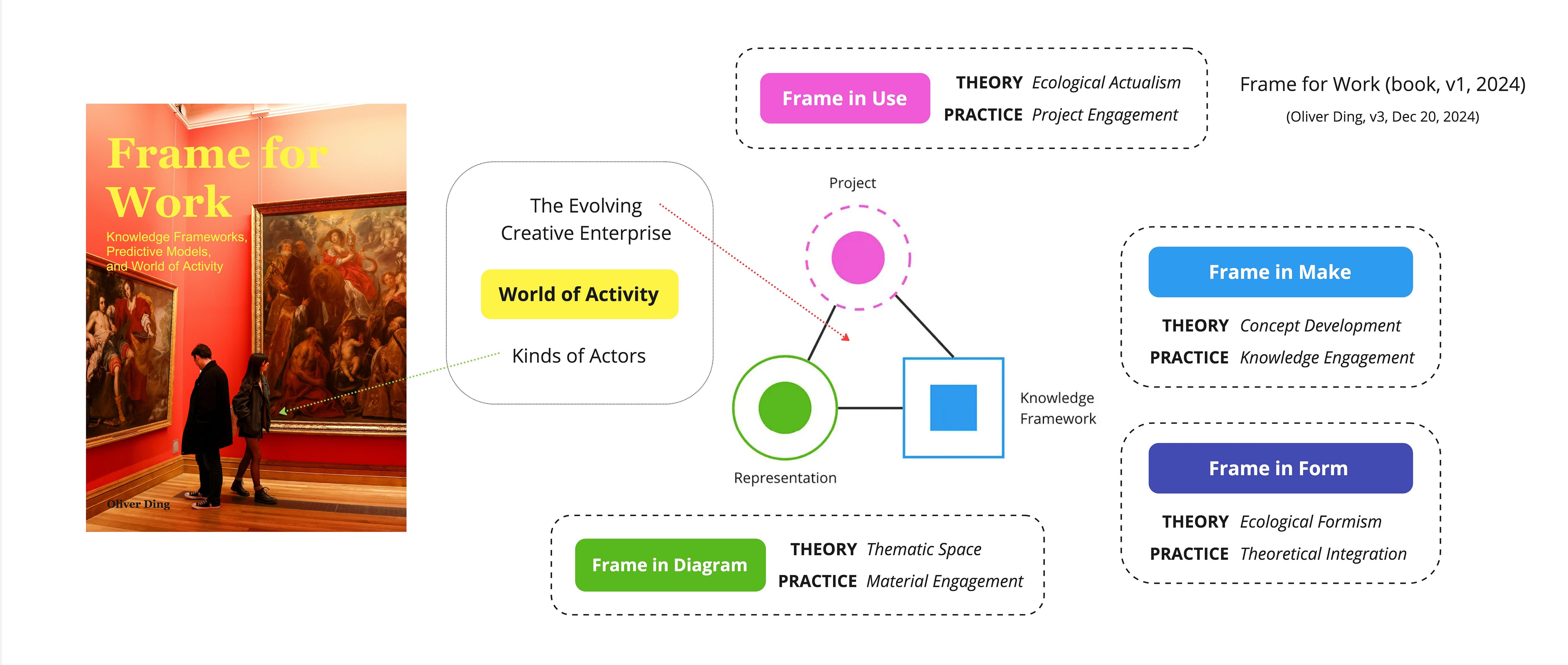
Part 1: Introduction
Part 1 provides the background of the Frame for Work project and recommends the article titled Creative Frameworks as a prototype for this book.
Chapter 1: The “Frame for Work” Project
This chapter collects several articles about the Frame for Work project, providing context for the book.
- May 10, 2023: A Possible Theme called “Frame for Work” — 8 min
- August 22, 2024: The “Frame for Work” Project (2024) — 9 min
Chapter 2: How to Understand Knowledge Frameworks?
This chapter introduces the book officially, summarizing approaches to knowledge frameworks and presenting a framework for editing this book.
Chapter 3: The Landscape of Creative Frameworks
This chapter serves as the seed and prototype of the book. If you lack time to explore the entire book, reading this chapter offers a quick tour.
- Creative Frameworks (Part 1) — 22 min
- Creative Frameworks (Part 2) — 24 min
Part 2: A Theory of Knowledge Frameworks
Part 2 presents the major theoretical resources behind the four perspectives, organized through relevant articles.
The primary theoretical frameworks are the Concept Development Framework, the Ecological Formism Framework, the Ecological Actualism Framework, and Thematic Space Theory.
Chapter 4: The Frame-in-Make Perspective
The Frame-in-Make perspective focuses on creating new knowledge frameworks through Knowledge Engagement, particularly the transformation from “Theme — Concept — Framework.”
Chapter 5: The Frame-in-Use Perspective
The Frame-in-Use perspective focuses on real-life applications of knowledge frameworks as predictive models for Project Engagement. A key theoretical resource is the Ecological Actualism Framework.
- The Ontology of Knowledge Frameworks and Ecological Actualism — 23 min
- The “Frameworks — Insights” Mapping — 18 min
Chapter 6: The Frame-in-Diagram Perspective
The Frame-in-Diagram perspective emphasizes diagrams as representations of knowledge frameworks and predictive models, centering on Material Engagement. The corresponding theoretical resource is the Thematic Space Theory framework.
- Kinds of Cognitive Representation and The Fifth Way of Knowing — 17 min
- Concept System, Diagram Network, and Knowledge Frameworks — 14 min
- [Creative Diagramming] Graphic Space Affordances, Thematic Space, and Possible Paths — 24 min
Chapter 7: The Frame-in-Form Perspective
The Frame-in-Form perspective centers on curating knowledge frameworks into a cohesive whole to bridge THEORY and PRACTICE, focusing on knowledge curation and Theoretical Integration. The theoretical resource is the Ecological Formism Framework.
Part 3: Building a Knowledge Framework
Part 3 adopts the Frame-in-Make perspective, focusing on the “Theme — Concept — Framework” transformation. The Concept Development framework inspires this approach.
In 2023, I developed a practical framework called “Strategic Thematic Exploration” to explore this transformation. This six-stage framework outlines the process from themes to a knowledge framework:
- A Possible Theme without a Clue
- A Possible Theme with a Clue
- A Primary Theme without Related Themes
- A Primary Theme with its Network
- A Knowledge Concept with a Working Definition
- A Knowledge Framework with a Set of Concepts
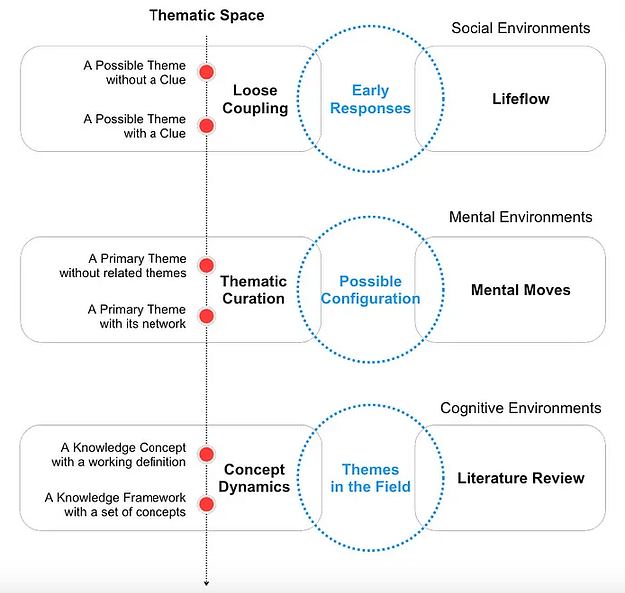
This model frames the contents of Part 3. A related book draft is Thematic Exploration: The Early Discovery of Knowledge Engagement (book, v1).
Chapter 8: The Theme — Concept — Framework Transformation
Chapter 9: Creative Clues
- link — 9 min
Chapter 10: Creative Themes
- link — 12 min
Chapter 11: Creative Concepts
- link — 24 min
Chapter 12: Creative Frameworks
Chapter 13: The Bottom-up Approach: The Mental Tuning Framework (2023)
The Bottom-up Approach is based on practice-based reflection and emphasizes induction reasoning. An example is the Mental Turning Framework (2023).
On September 9, 2023, I wrote Knowledge Engagement: The Concept of Mindset and Theoretical Integration, curating Carol S. Dweck’s version of Mindset theory and Peter Gollwitzer’s version of Mindset theory together. The outcome is the Mental Tuning framework.
- Knowledge Engagement: The Concept of Mindset and Theoretical Integration — 48 min
- Four Mindsets of Knowledge Engagement and “AAI as Mental Tuning” — 17 min
Chapter 14: The Top-down Approach: The Actualization of Supportances Framework (2021)
The Top-down Approach focuses on developing knowledge frameworks from predefined theoretical concepts. An example is the Actualization of Supportaqnces framework (2021).
- The Concept of Supportance — 38 min
Chapter 15: The Dialogue Approach: The Anticipatory Activity System (AAS) Framework (2022)
The Dialogue Approach refers to the connection between concepts and case studies. An example is the Anticipatory Activity System (AAS) framework (2022).
- The Development of AAS (2021 to 2022) — 17 min
- Value Circle #7: The Indirect Activity of Life Strategy Center — 24 min
Part 4: Predictive Models
Part 4 adopts the Frame-in-Use perspective, exploring the different contexts in which knowledge frameworks are used as Predictive Models, including knowledge engagement, material engagement, project engagement, and the creative journey.
Chapter 16: Predictive Models and Anticipatory Activity System
Predictive Models are a core concept of the Anticipatory Activity System (AAS) framework, which draws inspiration from Activity Theory, Anticipatory Systems theory, and other theoretical resources.
- The Predictive Model and Anticipatory Activity System — 8 min
- CALL for LIFE: Modeling A Developmental Project — 8 min
- A Five-space Model for Strategic Curation Activity — 14 min
Chapter 17: Predictive Models for Knowledge Engagement
A model can lead to a series of knowledge projects. In this chapter, the Thematic Space Canvas project and the Early Discovery project are used as examples.
- Case Study 1: The Thematic Space Canvas Project (link 1 — 11min, link 2 — 14 min)
- Case Study 2: The Early Discovery Project (link 1–14min, link 2–11 min)
Chapter 18: Predictive Models for Material Engagement
Editing a book can be seen as an example of material engagement. In this chapter, the Mental Moves project and the Meaning Discovery project are used as examples.
- Case Study 3: The Mental Moves Project (link 1 — 11 min, link 2 — 14 min)
- Case Study 4: The Meaning Discovery Project (link 1 — 15 min, link 2 — 11 min)
Chapter 19: Predictive Models for Project Engagement
In this chapter, two examples are selected for presenting the development of predictive models for following the development of projects.
- Creative Projects — 31 min
- Case Study 5: The Knowledge Center Project (link 1 — 16 min, link 2 — 27 min)
- Case Study 6: The Thematic Engagement Project (link 1 — 14 min, link 2–5 min, link 3 — 14 min)
Chapter 20: Predictive Models for Creative Journey
A Creative Journey comprises at least four Projects. If a Creative Journey aligns with a knowledge framework, that framework can be used as a model to understand and analyze the Journey.
- Creative Journey — 25 min
- Case Study 7: Appropriating Activity Theory (link 1)
- Case Study 8: The Development of Creative Life Theory (link 1 — 13 min, link 2 — 9 min, link 3 — 12 min)
Part 5: Maps and Methods
Part 5 adopts the Frame-in-Diagram perspective and focuses on a particular type of diagram: thematic maps. Relevant methods are also introduced in this part.
Chapter 21: The Journey of Building Thematic Space Theory
In this chapter, we will explore three concepts: an example of the Thematic Map, the Mapping Strategic Moves method, and Thematic Space Theory.
Chapter 22: A Typology of Knowledge Diagrams
This chapter provides an overview of different types of knowledge diagrams.
Chapter 23: Thematic Maps
Inspired by Thematic Space Theory, I designed a series of Thematic Maps in 2024.
- The House of Project Engagement — 29 min
- The House of Creative Life Strategy — 25 min
- The House of Knowledge Discovery — 18 min
- The House of Thematic Genidentity — 32 min
- Ecological Strategic Cognition: A Theory of Strategy (v1, 2024) — 17 min
Chapter 24: The Mapping Strategic Moves Method
The Mapping Strategic Moves method is based on a series of Thematic Maps, including the House of Project Engagement and others.
Chapter 25: The Strategic Life Narrative Method
The House of Creative Life Curation is organized around 12 themes, grouped into three categories: Theme, Practice, and Space. These 12 themes form the foundation for developing 12 distinct types of Strategic Life Narrative practices.
- The House of Creative Life Curation — 12 min
- From Creative Life Curation to Strategic Life Narrative — 14 min
- The Strategic Life Narrative Practice #0 (Introduction) — 17 min
Chapter 26: Methods for Curating Possible Journeys
This chapter introduces four methods or techniques for curating possible journeys: 1) Deep Analogy, 2) Creative Swapping, 3) Spatial Engagement, and 4) Topological Mapping.
Part 6: World of Activity
Part 6 moves to creators and their World of Activity. This part introduces the concept of “World of Activity” and presents a typology of actors, including General Actors, Professionals, Empirical Researchers, and Theoretical Researchers.
Chapter 27: The Concept of World of Activity
The concept of “World of Activity” describes a creative person’s maximum scope throughout their creative life course.
- Lifescope: The World of Activity for Creative Life Curation — 14 min
- A Universal Reference for Knowledge Engagement — 13 min
Chapter 28: Kinds of Actors
Building on the Universal Reference for Knowledge Engagement, a typology of actors is introduced, identifying four categories: General Actors, Professionals, Empirical Researchers, and Theoretical Researchers.
- Kinds of Actors — 12 min
- Four Perspectives and Creative Identities (12 min)
Chapter 29: A Strategic Map for Creative Frameworks
The “Theory, Practice, End, Means” structure outlines four thematic areas and a set of thematic zones, providing a map for understanding the “Theme — Concept — Framework” transformation across diverse social contexts.
- Knowledge Discovery Canvas — 14 min
- The “Grasping the Concept” Model — 6 min
- Kinds of Concept-related Knowledge Engagement — 3 min
Part 7: Adjustable Wisdom
Part 7 adopts the Frame-in-Form perspective, moving from PRACTICE to THEORY, introducing the Ecological Formism framework and related case studies.
Chapter 30: The Attachance Approach to Social Cognition
This chapter introduces an integrated ecological approach to social cognition, including two sub-frameworks: the Ecological Formism framework and the Ecological Actualism framework.
- Social Moves: The Attachance Approach to Social Cognition — 13 min
- Mental Moves: The Attachance Approach to Ecological Creative Cognition — 16 min
- Strategic Moves: Mapping Knowledge Engagement and Structural Choice — 14 min
Chapter 31: The Ecological Formism Framework
The Ecological Formism framework is an epistemological framework that identifies six units of analysis through four types of knowing. The schema “Variant > Quasi-invariant > Invariant > Invariant Set” defines these types.
- The Hermeneutics of Knowledge Frameworks and Ecological Formism — 23 min
- The “Thematic Space” Level: Thematic Zones, Thematic Areas, and Social Territory — 26 min
- The “Diagram” Level: The Ecological Formism Approach to Diagrams — 10 min
Chapter 32: Basic Forms, Derived Forms, and Ecological Metaphors
The Ecological Formism Framework uses the schema “Variant > Quasi-invariant > Invariant > Invariant Set” as the foundation to define four types of entities about Knowledge Frameworks:
- Invariant: Basic Forms
- Invariant Set: Frames
- Quasi-invariant: Derived Forms
- Variant: Frameworks
This chapter includes a case study on Basic Forms and Derived Forms.
- Case Study: The Basic Form of “Creative Dialogue” — 14 min
- Ecological Metaphor and Meta-diagrams — 14 min
- Advanced Model vs. Basic Model vs. Standard Model — 14 min
Chapter 33: Knowledge, Wisdom, and Activity
This chapter examines the dynamic relationship between Mental Models (Predictive Models) and Projects.

The “Predict — Adjust” interactions parallel the “Learn — Share” interactions. While the former explores mental moves between “Knowledge” and “Wisdom,” the latter focuses on mental moves between “Wisdom” and “Activity.”
- Mental Models and the Attachance of Multiple Moves — 18 min
- Four Mindsets of Knowledge Engagement and “AAI as Mental Tuning” — 17 min
Part 8: The Evolving Creative Enterprise
Part 8 reviews the model of Evolving Knowledge Enterprise and shares the latest developments in my creative journey, highlighting the expansion from Knowledge Engagement to Cultural Engagement.
Chapter 34: The Landscape of Evolving Knowledge Enterprise
In November 2023, I developed a model for “Developing a Concept System,” emphasizing three dimensions: mental platform (how you think), behavioral network (how you act), and material container (what you create). This model culminated in the Landscape of Evolving Knowledge Enterprise in April 2024.
Chapter 35: Beyond Knowledge Engagement
In recent projects, I expanded from Knowledge Engagement to Cultural Engagement, shifting my focus from Creative Life Development to Social Life Development.
- From Creative Life Curation to Strategic Life Narrative — 14 min
- The Strategic Life Narrative Practice #0 (Introduction) — 17 min
- The Theme of “HELLO THEORY” and Three Possible Projects — 18 min
- GO Theory: The Genidentity-opportunity Approach (v1, 2024) — 6 min
- The Creative Identity Engagement Framework (v1, 2023) — 2 min
A New Knowledge Center
This possible book marks a significant milestone in my exploration of themes, concepts, and frameworks.
In 2025, I will launch a new knowledge center to continue the work inspired by this book. More details will be shared in January 2025.

The logo above represents the design for the new knowledge center.
